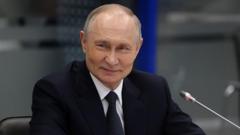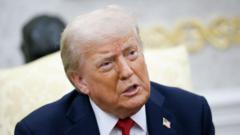Despite recent trade discussions, the underlying economic battles loom large.
China-Made Moves: Unpacking Trade Talks Progress with the US

China-Made Moves: Unpacking Trade Talks Progress with the US
Negotiations signal a shift in China and US trade dynamics amid ongoing tensions.
China's trade dialogue with the United States has shown new developments that signal both progress and ongoing challenges. The recent negotiations aimed at tariff relief were marked by contrasting narratives from both sides, depicting a complicated relationship that remains fraught.
The trade war, characterized by Chinese resilience against former President Trump's tariffs, saw Beijing project a defiant image. As high tensions rose, many turned to social media to convey the absurdity of the situation. “We will not yield,” was a message often echoed across Chinese diplomatic channels. As delegates convened in Switzerland, a state-run account shared a cartoon portraying the US Treasury Secretary beside an empty shopping cart, accentuating their stance.
Recently, discussions led by US Treasury Secretary Scott Bessent highlighted a mutual interest in maintaining trade ties, with both parties indicating a reluctance for economic decoupling. An informal consensus emerged from the Geneva meetings that the heavy tariffs imposed previously felt akin to an embargo—a situation that neither side is eager to face.
Economists evaluated this latest agreement positively. Zhiwei Zhang of Pinpoint Asset Management in Hong Kong noted that tariff cuts, reducing US tariffs on Chinese goods to 30% and Chinese tariffs on US goods down to 10%, exceed initial expectations. This agreement signals a more hopeful outlook for both nations and the global markets, easing fears regarding the interruption of supply chains.
Trump hailed the discussions on social media, describing them as cordial and productive, while China adopted a noticeably softer tone. However, during these negotiations, concerns remained about the strain of economic pressures on the Chinese economy, which is grappling with a property crisis and rising unemployment among youth, leading to decreased consumer spending. The impact on large US firms like Apple, which heavily relies on Chinese manufacturing, remains a concern as well.
Following the agreement, the Chinese Commerce Ministry emphasized the need for continued dialogue to resolve differences. However, buried within the optimism was a cautionary note, urging the US to correct its "wrong practices" and warning Washington of China's limits in goodwill. Leaders in Beijing are keen on portraying strength and responsibility, especially amidst a backdrop of a potentially global economic downturn.
While experts and enthusiasts celebrate the temporary pause in hostilities, it's clear that complications remain. The structural trade imbalance, which sees China exporting far more to the US than importing, continues to serve as a sticking point, as does an array of other contentious issues like government subsidies and military tensions in the Taiwan Strait.
The landscape of the China-US trade relationship has merely shifted, moving away from simple transactions to a deeper, ongoing negotiation process. The battle for a fairer trade balance is far from concluded, with both nations mindful that the road ahead will require ongoing commitment and strategic dialogue.
The trade war, characterized by Chinese resilience against former President Trump's tariffs, saw Beijing project a defiant image. As high tensions rose, many turned to social media to convey the absurdity of the situation. “We will not yield,” was a message often echoed across Chinese diplomatic channels. As delegates convened in Switzerland, a state-run account shared a cartoon portraying the US Treasury Secretary beside an empty shopping cart, accentuating their stance.
Recently, discussions led by US Treasury Secretary Scott Bessent highlighted a mutual interest in maintaining trade ties, with both parties indicating a reluctance for economic decoupling. An informal consensus emerged from the Geneva meetings that the heavy tariffs imposed previously felt akin to an embargo—a situation that neither side is eager to face.
Economists evaluated this latest agreement positively. Zhiwei Zhang of Pinpoint Asset Management in Hong Kong noted that tariff cuts, reducing US tariffs on Chinese goods to 30% and Chinese tariffs on US goods down to 10%, exceed initial expectations. This agreement signals a more hopeful outlook for both nations and the global markets, easing fears regarding the interruption of supply chains.
Trump hailed the discussions on social media, describing them as cordial and productive, while China adopted a noticeably softer tone. However, during these negotiations, concerns remained about the strain of economic pressures on the Chinese economy, which is grappling with a property crisis and rising unemployment among youth, leading to decreased consumer spending. The impact on large US firms like Apple, which heavily relies on Chinese manufacturing, remains a concern as well.
Following the agreement, the Chinese Commerce Ministry emphasized the need for continued dialogue to resolve differences. However, buried within the optimism was a cautionary note, urging the US to correct its "wrong practices" and warning Washington of China's limits in goodwill. Leaders in Beijing are keen on portraying strength and responsibility, especially amidst a backdrop of a potentially global economic downturn.
While experts and enthusiasts celebrate the temporary pause in hostilities, it's clear that complications remain. The structural trade imbalance, which sees China exporting far more to the US than importing, continues to serve as a sticking point, as does an array of other contentious issues like government subsidies and military tensions in the Taiwan Strait.
The landscape of the China-US trade relationship has merely shifted, moving away from simple transactions to a deeper, ongoing negotiation process. The battle for a fairer trade balance is far from concluded, with both nations mindful that the road ahead will require ongoing commitment and strategic dialogue.





















